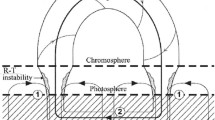Abstract
It is found that thin magnetic tubes of radius about 107-108 cm and longitudinal current 1011-1012 A can be generated under the conditions of convective flows in the solar photosphere. Moreover, the so-called “magnetic holes”, cylindrical magnetic structures with magnetic field decreasing towards the center, can be formed in divergent convective (Evershed) flows. It is shown that the steady-state Joule energy release (dissipation) at the photospheric footpoints of a magnetic tube increase towards the tube periphery in the upper photosphere and can exceed the optical radiation losses. In particular, this can lead to the occurrence of magnetic tubes with hot external envelopes.
We consider two models of magnetic flaring loops in the active region. One model describes the explosive energy release in an individual loop caused by the penetration of the dense partially ionized plasma of a prominence into the magnetic tube (in the upper part of the loop) due to flute instability or the penetration of the surrounding chromospheric plasma (in the chromospheric part of the loop). The inflow of these plasmas destroys the force-free structure of the magnetic tube and switches on an efficient mechanism of energy release due to ion-atom collisions in a non-steady-state plasma. We studied the dynamics of the joule energy release in such processes. The second model of flaring energy release is based on the global approach in the study of the dynamics and energetics of solar active regions with allowance for their complex self-consistent evolution. The structure of the magnetic field of an active region was represented as an ensemble of inductively coupled current-carrying magnetic loops interacting with each other. Each loop, in turn, was simulated by an equivalent electric circuit with variable parameters as a function of the shape, scale, and position of the loop in the ensemble as well as of the plasma temperature and density in the magnetic tube. Using this model, we showed that a rising magnetic loop can cause thermal flare-like heating of one loop and cooling of other loops in the ensemble.
Similar content being viewed by others
References
J. C. Henoux, and B. V. Somov,Astron. Astrophys.,241, 613 (1991).
E. R. Priest,Solar Magnetohydrodynamics, Reidel, Dordrecht (1982).
H. Zirin,Vistas. Astron.,16, 1 (1974).
E. N. Parker,Sol. Phys.,121, 431 (1989).
L. Vlahos,Sol. Phys.,121, 453 (1989).
D. B. Melrose, and J. I. Khan,Astron. Astrophys.,219, 308 (1989).
H. K. Sen, and M. L. White,Sol. Phys.,23, 146 (1972).
D. F. Spicer,Sol. Phys.,53, 305 (1977).
T. Gold,Mon. Not. R. Astron. Soc.,120, 89 (1960).
T. Tajima, F. Brunel, and J. Sakai,Astrophys. J.,258, L45 (1982).
T. Tajima, J. Sakai, T. Nakajima, et al.,Astrophys. J.,321, 1031 (1987).
J. Heyverts, E. R. Priest, and D. Rust,Astrophys. J.,216, 213 (1977).
P. A. Sturrock,Astrophys. J.,S73, 79 (1968).
H. Alfven, and D. Carlquist,Sol. Phys.,1, 220 (1967).
V. V. Zaitsev, and A. V. Stepanov,Sol. Phys.,139, 343 (1992).
J. R. Kan, S.-I. Akasofu, and L. C. Lee,Sol. Phys.,84, 153 (1983).
D. B. Melrose, and A. N. McClymont,Sol. Phys.,113, 241 (1987).
M. S. Wheatland, and D. B. Melrose,Sol. Phys.,159, 137 (1995).
V. V. Zaitsev, S. Urpo, and A. V. Stepanov, in: Proc. URSI/IEEE/IRC XXI Convention on Radio Science, Otaniemi, Finland (1996), p. 46.
M. L. Khodachenko,Astron. Zh.,73, No. 2, 303 (1996).
E. N. Parker,Astrophys. J.,264, 642 (1985).
Z. M. Mikic, D. C. Barnes, and D. D. Schnack,Astrophys. J.,328, 830 (1988).
A. A. van Ballegooijen,Astrophys J.,311, 1001 (1986).
V. V. Zaitsev, O. G. Parfenov, and A. V. Stepanov,Sol. Phys.,60, 279 (1978).
G. Peres, R. Rosner, S. Serio, and G. S. Vaiana,Astrophys. J.,252, 791 (1982).
Additional information
Institute of Applied Physics, Russian Academy of Sciences, Nizhny Novgorod. Translated from Izvestiya Vysshikh Uchebnykh Zavedenii, Radiofizika, Vol. 40, Nos. 1–2, pp. 176–212, January–February, 1997.
Rights and permissions
About this article
Cite this article
Zaitsev, V.V., Khodachenko, M.L. Energy release in corona magnetic loops. Radiophys Quantum Electron 40, 114–138 (1997). https://doi.org/10.1007/BF02677830
Received:
Issue Date:
DOI: https://doi.org/10.1007/BF02677830




